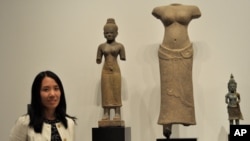Here in Pasadena, California, the Norton Simon Museum is well known for extraordinary collections of art from around the world. The exterior is designed in a modern style, with a curvilinear face. It’s not the kind of place you would expect to find one of the best collections of Khmer art in the US. But it’s here.
Giant Khmer statues greet the museum visitor, but the real trove is downstairs, where the museum’s Khmer collection shines bright.
Melody Rod-ari is the curator of the collection. She walked me through her favorite works.
“This is a sculpture of Harihara,” she explained. “He is half Vishnu and half Shiva. Harihara became very important to the Khmer kings. These types of sculpture were made all the way up to the 13th Century, but they were very popular from 7th to 9th. I think today it is easy to forget that Hinduism was a very important religion in Cambodia and all of Southeast Asia, because today everyone practices Theravada Buddhism. But Hinduism was very important, so we have a lot of these earlier Hindu images.”
She beckoned me closer. On the rights side was Vishnu, holding a conch shell, a chakra wheel and a mound of earth specific to Cambodian art. “In Indian art, he does not hold the mound of earth,” Rod-ari said. “He holds the lotus flower and the club.”
Harihara’s face had just half of Shiva’s third eye, with matted hair. “It is believed that Shiva does not like to take showers, so that’s why he has the dreadlocks,” she said. “This is not a very large sculpture, just about 26 inches, but in terms of quality it is very fine.”
Her favorite, she said, was a giant image of Vishnu.
“He is larger than life and bigger and taller than any person that you would meet,” she said as we stood before the statue. “Something this large would have been inside of the temple. The surface of this sculpture is shiny; this is typical of what you would have seen during the Angkor period. This is because the artist wanted to make sure that the object was beautiful.
“This is not just the image of the god,” she said. “It’s supposed to represent the real gods themselves, so Vishnu is supposed to be embodied in this image.”
Vishnu held a ball of earth, “absolutely a Cambodian invention,” she said. “You don’t see this in any other place.”
The 10th-Century statue had holes in his earlobes, a testament to his importance, Rod-ari said.
“He probably wore real gold earrings and bracelets, rings, and necklaces and real clothes,” she said. “So these are the star pieces at the Norton Simon Museum.”
Rod-ari is currently cooperating with the Getty Museum in Los Angeles, where a visiting collection of bronze sculptures from the National Museum of Cambodia is on display.
She held the first half of an appreciation workshop at the Norton Simon over the weekend, to help demonstrate Hinduism and Buddhism, how they came to Cambodia, “and how objects were used, that they were not just objects, they were actually gods and goddesses,” she said. “People actually love and took care of them.”
This Saturday, she’ll move to the Getty, where she’ll use the “Gods of Angkor” bronze exhibit to help students learn about Angkor Wat and its history.
The Norton Simon also has an exhibit that ends Aug. 1 called “Where Art Meets Science,” designed to show how difficult finding the origin of an art object can be. This exhibit also focuses on the Khmer art collection at the museum.
Between that exhibit and “Gods of Angkor,” now is the best time to see premier collections of ancient Khmer art.
“The Norton Simon Museum has a good collection of the art,” Rod-ari said, “but to have the bronzes from the National Museum in Phnom Penh was a real treasure for all of us who live in Los Angeles.”





